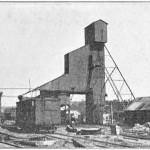Posted by Maeve on Monday, Feb 1, 2016
Southern Iowa was once the site of a thriving coal mining industry and one of the most interesting coal mining communities was Buxton. The library
 is hosting a display, No Roads Lead to Buxton, from the African American Museum of Iowa on the first floor of the library during the first week of Black History Month, February 1 - February 7.
is hosting a display, No Roads Lead to Buxton, from the African American Museum of Iowa on the first floor of the library during the first week of Black History Month, February 1 - February 7.
 Buxton, a once prosperous coal mining community in Bluff Creek Township in northern Monroe County, holds a special place in Iowa history as a predominantly black town. Beginning in the 1890s Ben Buxton, the President and principal stockholder of the Consolidation Coal Company and North Western Railroad of Chicago, recruited black laborers to work in the coal mines of Iowa following strikes by white miners. The majority of the recruits settled in the town of Buxton, founded by the company in 1895 to house the new arrivals. Most of the miners were from the Virginia and West Virginia coal mining regions. By 1905, Buxton had nearly 2,700 African Americans and 1,990 Europeans, mostly of Swedish, Welsh, and Slovak descent. At its peak in 1910, Buxton’s population was between eight and ten thousand people.
Buxton, a once prosperous coal mining community in Bluff Creek Township in northern Monroe County, holds a special place in Iowa history as a predominantly black town. Beginning in the 1890s Ben Buxton, the President and principal stockholder of the Consolidation Coal Company and North Western Railroad of Chicago, recruited black laborers to work in the coal mines of Iowa following strikes by white miners. The majority of the recruits settled in the town of Buxton, founded by the company in 1895 to house the new arrivals. Most of the miners were from the Virginia and West Virginia coal mining regions. By 1905, Buxton had nearly 2,700 African Americans and 1,990 Europeans, mostly of Swedish, Welsh, and Slovak descent. At its peak in 1910, Buxton’s population was between eight and ten thousand people.
The majority of the leadership roles in Buxton were held by African Americans -the postmaster, superintendent of schools, most of the teachers, two justices of the peace, two constables and two deputy sheriffs. Buxton’s most prominent early resident, E.A. Carter, the son of a black miner who arrived in the 1890s, is believed to be he first black graduate from the University of Iowa, Medical College, in 1907. Dr. Carter returned to Buxton where he became assistant chief surgeon for Consolidated Coal. In 1915 he was appointed chief surgeon for the company. Prominent attorneys and one-time Buxton residents George H. Woodson and Samuel Joe Brown were among the co-founders of the Niagra Movement, a predecessor to the National Association for the Advancement of Colored People (NAACP), in 1905.
Schools in Buxton were racially integrated and taught by both black and white instructors. The Consolidated Coal also treated blacks and whites equally, with regards to housing and employment matters. Buxton changed during the start of World War I in France. Coal production had peaked and the black population began to slowly decline. Fires destroyed buildings and homes in Buxton, and by 1919, there were only a few hundred of people left. In 1923, the coal company moved its headquarters and sold out to the Superior Coal Company in 1925. The Buxton mine closed in 1927.
Drop by the library to learn more about Buxton, a fascinating chapter in Iowa history.

